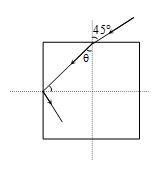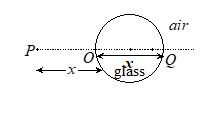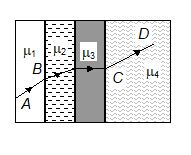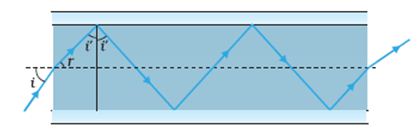Video Lecture
Theory For Notes Making
Lorem ipsum dolor sit amet, consectetur adipiscing elit. Ut elit tellus, luctus nec ullamcorper mattis, pulvinar dapibus leo.
Objective Assignment
Q.1
The principle of optical fibre is
(a) Diffraction
(b) Polarisation
(c) Interference
(d) Total Internal reflection
Ans. (d)
Q.2
A ray of light strikes a glass plate at an angle of 60° with the vertical. If the reflected and refracted rays are perpendicular to each other, the refractive index of glass is
(a) \frac{{\sqrt{3}}}{2}
(b) \frac{3}{2}
(c) \frac{1}{2}
(d) \sqrt{3}
Ans. (d)
Q.3
Light travels through a glass plate of thickness t and having refractive index m. If c be the velocity of light in vacuum, the time taken by the light to travel this thickness of glass is
(a) \frac{t}{{\mu \ c}}
(b) t m c
(c) \frac{{\mu \,t}}{c}
(d) \frac{{\mu \,t}}{c}
Ans. (c)
Q.4
The length of a vertical pole above the surface of a lake of water (n = 4/3) is 24 cm. To an under-water fish just below the water surface the tip of the pole appears to be
(a) 18 cm above the surface
(b) 24 cm above the surface
(c) 32 cm above the surface
(d) 36 cm above the surface
Ans. (c)
Q.5
A ray incident at a point at an angle of incidence of 600 enters a glass sphere of R.1. and gets reflected and refracted at the farther surface of the sphere. The angle between the reflected and refracted rays at this surface is
(a) 500 (b) 600 (c) 900 (d) 400
Ans. (c)
Q.6
A circular beam of light of diameter d = 2 cm falls on a plane surface of glass. The angle of incidence is 600 and refractive index of glass is m = 3/2. The diameter of the refracted beam is
(a) 4.0 cm (b) 3.0 cm (c) 3.26 cm (d) 2.52 cm
Ans. (c)
Q.7
Light wave enters from medium 1 to medium 2. Its velocity in 2nd medium is double from 1st. For total internal reflection the angle of incidence must be greater than
(a) 30° (b) 60° (c) 45° (d) 90°
Ans. (a)
Q.8
The refractive index of water is 4/3 and that of glass is 5/3. Then the critical angle for a ray of light entering in water from glass will be
(a) {{\sin }^{{-1}}}\left( {\frac{4}{5}} \right)
(b) {{\sin }^{{-1}}}\left( {\frac{5}{4}} \right)
(c) {{\sin }^{{-1}}}\left( {\frac{{20}}{9}} \right)
(d) {{\sin }^{{-1}}}\left( {\frac{9}{{20}}} \right)
Ans. (a)
Q.9
A plano-convex lens has a thickness of 4 cm. When placed on a horizontal table with curved surface in contact with it, the apparent depth of the bottom most point of the lens is found to be 3 cm. If the lens is inverted such that the plane face is in contact with the table, the apparent depth of the centre of plane face is found to be 25/8 cm. The focal length of the lens is
(a) 50 cm (b) 75 cm (c) 100 cm (d) 150 cm
Ans. (b)
Q.10
A light ray falls on a square slab at an angle 45°. What must be the minimum index of refraction of glass, if total internal reflection takes place at the vertical face?

(a) \frac{{\sqrt{3}}}{2}
(b) \sqrt{{\frac{3}{2}}}
(c) \frac{3}{2}
(d) \frac{3}{{\sqrt{2}}}
Ans. (b)
Q.11
A spherical surface of radius of curvature R separates air (refractive index 1.0) from glass (refractive index 1.5). The centre of curvature is in the glass. A point object P placed in air is found to have a real image Q in the glass. The line PQ cuts the surface at a point O, and PO =OQ. The distance PO is equal to

(a) 5R (b) 3R (c) 2R (d) 1.5R
Ans. (a)
Q.12
A ray of light passes through four transparent media with refractive indices m1, m2, m3 and m4 as shown in the figure. The surface of all media are parallel. If the emergent ray CD is parallel to the incident ray AB, then

(a) m1 = m2 (b) m2 = m3 (c) m3 = m4 (d) m4 = m1
Ans. (d)
Subjective Assignment
Q.1
At what angle of incidence should a light beam strike a glass slab of refractive index \displaystyle \sqrt{3}, such that the reflected and the refracted rays are perpendicular to each other ?
Q.2
A glass lens of refractive index 1.45 disappears when immersed in a liquid. What is the value of refractive index of the liquid ?
Q.3
State the conditions for the phenomenon of total internal reflection to occur.
Q.4
Calculate the speed of light in a medium whose critical angle is 30º.
Q.5
When light travels from a rarer to a denser medium, the speed decreases. Does this decrease in speed imply a decrease in the energy carried by the light wave ? Justify your answer.
Q.6
When light travels from a rarer to a denser medium, the speed decreases. Does this decrease in speed imply a decrease in the energy carried by the light wave ? Justify your answer.
Q.7
Under what condition does the formation of rainbow occur ?
Q.8
If a ray of light propagates from a rarer to a denser medium, how does its frequency change ?
Q.9
A small bulb is placed at the bottom of a tank containing water to a depth of 80cm. What is the area of the surface of water through which light from the bulb can emerge out? Refractive index of water is 1.33. (Consider the bulb to be a point source.)
Ans: Area = 2.6 \displaystyle {{m}^{2}}
Q.10
(i) What is the relation between critical angle and refractive index of a material ?
(ii) Does critical angle depend on the colour of light ? Explain.
Q.11
Explain the scattering of light with an example.
Q.12
(i) State the principle on which the working of an optical fiber is based.
(ii) What are the necessary conditions for this phenomenon to occur ?
Q.13
A tank is filled with water to a height of 12.4 cm. The apparent depth of a needle lying at the bottom of the tank is measured by a microscope to be 9.3 cm. What is the refractive index of water ? If water is replaced by a liquid of refractive index 1.6 upto the same height, by what distance would the microscope have to be moved to focus on the needle again ?
Q.14
Define total internal reflection. State its essential conditions.
Q.15
Answer the following questions:
(a) A diver under water, looks obliquely at a fisherman standing on the bank of a lake. Would the fisherman look taller or shorter to the diver than what he actually is?
(b) Does the apparent depth of a tank of water change if viewed obliquely? If so, does the apparent depth increase or decrease?
(c) The refractive index of diamond is much greater than that of ordinary glass. Is this fact of some use to a diamond cutter?
16.
Figures (a) and (b) show refraction of a ray in air incident at 60° with the normal to a glass-air and water-air interface, respectively. Predict the angle of refraction in glass when the angle of incidence in water is 45º with the normal to a water-glass interface [Fig. (c)].

17.
(a)
Figure shows a cross-section of a ‘light pipe’ made of a glass fibre of refractive index 1.68. The outer covering of the pipe is made of a material of refractive index 1.44. What is the range of the angles of the incident rays with the axis of the pipe for which total reflections inside the pipe take place, as shown in the figure.
(b)
What is the answer if there is no outer covering of the pipe?

Ans
(a)
range 0 < I < 60º
(b)
All incident rays (in the range 53.5º < I < 90º) will suffer total internal reflections
